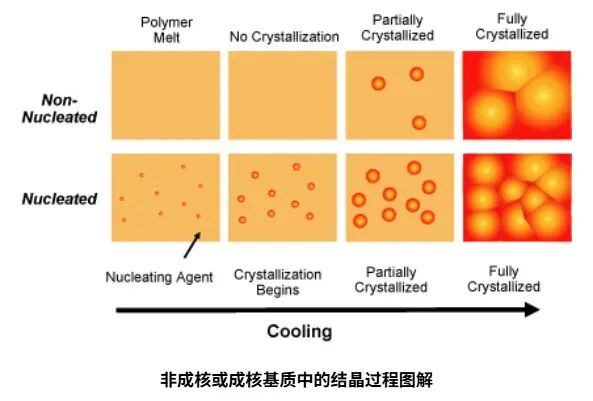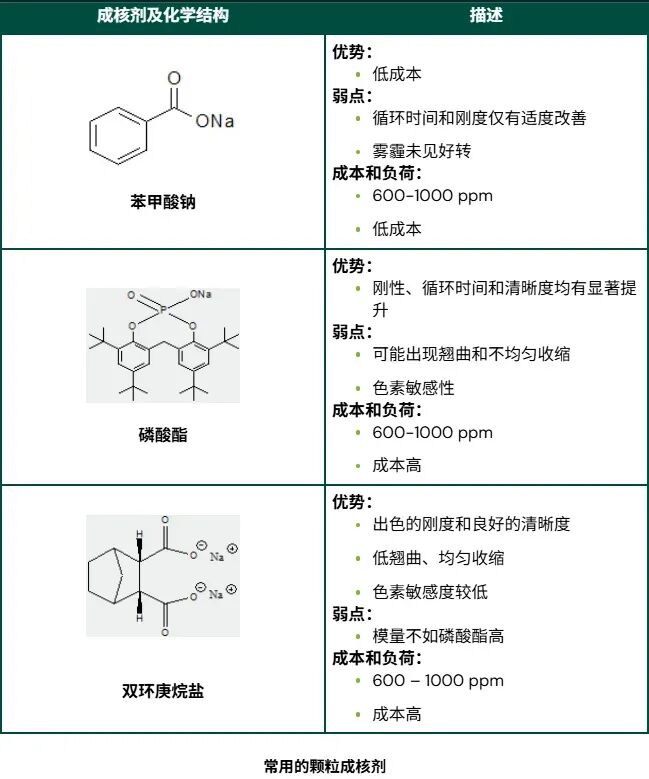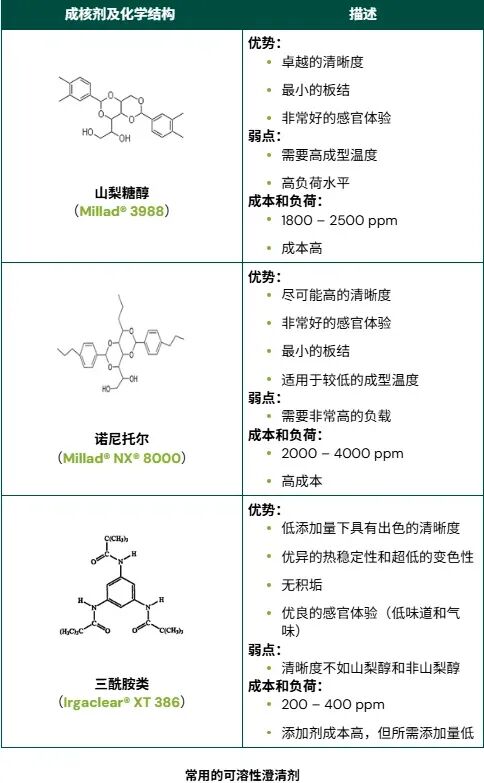A comprehensive analysis of various types of nucleating agents: Classification, Characteristics, and Factors Affecting Their Performance
The crystallinity of semi-crystalline polymers determines many of their properties, such as dimensional stability, transparency, and toughness. For specific parts and processes, crystallinity is controlled by the polymer structure, formulation, and processing conditions, leading to a specific balance of heat accumulation and cooling. Therefore, crystallinity often exhibits heterogeneity, with different thermal histories at the surface and core of the part or product.
Nucleation is an effective method for improving the physical, mechanical, and optical properties of polymers. Carefully selecting nucleating agents or clarifiers can enhance their transparency, dimensional stability, warpage, shrinkage, coefficient of linear thermal expansion (CLTE), heat deflection temperature (HDT), mechanical properties, and barrier effects.

Today, we will provide a detailed explanation of the classification of the "nucleating agents" family.Factors Affecting the Performance of Nucleating Agents and Clarifying Agents。
Nucleating agent for particles
Granular nucleating agents are typically high-melting compounds that are mixed and dispersed in a polymer melt. These particles act as unique "nucleation sites" on which polymer crystals can begin to grow.
High concentrations of nucleating agents can lead to faster crystallization (shorter cycle times) and higher crystallinity, thereby improving the strength, rigidity, and HDT of polymers. If the crystal aggregates (spherulites) are smaller in size, light scattering can be reduced and clarity can be improved. Commonly used particulate nucleating agents include salts and minerals such as talc, sodium benzoate, phosphate esters, and other organic salts.
Talcum powder and sodium benzoateIt is considered a low-performance, low-cost nucleating agent, and it provides moderate improvements in strength, stiffness, HDT, and cycle time.
High-performance, high-cost nucleating agents, such asPhosphate ester and bicycloheptane saltIt can provide better physical properties and improve transparency to a certain extent.

Soluble nucleating agent
Soluble nucleating agents, also known as "melt-sensitive type," typically have a lower melting point and dissolve in molten PP. When the polymer melt cools in the mold, these nucleating agents crystallize first, forming a finely distributed network with an extremely high surface area. As the temperature continues to drop, the fibers constituting this network act as cores, initiating polymer crystallization.
The extremely high concentration of crystal nuclei results in very small PP crystal aggregates, thereby producing the lowest level of light scattering and optimal clarity.
All clarifying agents are nucleating agents, but not all nucleating agents are good clarifying agents. Some common nucleating agents, such as sodium benzoate and talc, cannot sufficiently reduce spherulite size, thus failing to achieve low haze and high transparency in molded parts. Typically, using soluble nucleating agents can achieve optimal transparency. Soluble organic compounds that can be used as clarifying agents include sorbitol, nonanol, and trisamide.
Although these nucleating agents are primarily used to achieve high clarity and low haze, they can also improve physical properties and reduce cycle time.

Other categories
Nucleating agents and clarifying agents can also be classified according to their chemical families and crystal types.
1. Inorganic and organic nucleating agents
Inorganic additives such as talc or barium sulfate, and nanoclays (such as montmorillonite) have a nucleating effect on polypropylene, thermoplastic polyesters, and polyamides, which can accelerate the nucleation rate and increase the overall crystallinity. Additionally, the use of metal oxides (such as titanium dioxide or magnesium oxide), phosphates, carbonates, or sulfates (preferably alkaline earth metals) is also recommended.
Organic additives come in a wide variety, ranging from sorbitol derivatives to mono- or polycarboxylic acids and their salts, such as 4-tert-butylbenzoic acid, sodium benzoate, organic phosphates or phosphoric esters, adipic acid, diphenylacetic acid, sodium succinate, or sodium benzoate; norbornane carboxylate, polymers such as ionomers (ionomer resins), nitrogen and more or less complex molecules such as triphenodithiazine, dicyclohexyl-2,6-naphthalenedicarboxamide, heptanoic acid with calcium stearate or quinacridone pigment Permanent Red.
2. Classification according to the most favored crystal types: α, β, γ...
The most effective α-nucleating agents are sorbitol derivatives and organic phosphates, while β-nucleating agents include trisamide dithiazine, pimelic acid with calcium stearate, or quinacridone pigment Permanent Red.
Factors Affecting the Performance of Nucleating Agents and Clarifying Agents
(Using polypropylene as an example)
Grain shape and aspect ratio
Needle-shaped nucleating agents (such as ADK STAB NA-11) can cause differences in longitudinal and transverse shrinkage rates. This shrinkage anisotropy can lead to warping of the final parts. Plate-shaped nucleating agents (such as Hyperform® HPN® 68L) can make shrinkage more uniform in both directions, thereby reducing warping.
Grain size and grain size distribution
Smaller particle sizes result in better nucleation effects, but smaller particles are also more difficult to disperse. Some nucleating particles, such as sodium benzoate, tend to re-agglomerate easily.
Use a deacidifier.
Some acid scavengers, such as fatty acid salts (e.g., calcium stearate), may exhibit antagonistic effects with certain nucleating agents (e.g., phosphate esters and sodium benzoate). Dihydro talc (DHT 4A®) should be used with these nucleating agents.
Do not use calcium stearate together with sodium benzoate, as calcium stearate will completely offset the nucleating effect of sodium benzoate.
The presence of dispersion and undispersed agglomerates
Sodium benzoate often forms agglomerates and is difficult to disperse properly.
Melt temperature
Sorbitol requires a higher melting temperature to achieve optimal transparency because they must be completely dissolved in the polymer melt. Other soluble clarifiers, such as Irgaclear® XT 386, can dissolve in polypropylene at lower temperatures and are less sensitive to melting temperature.
How to add nucleating agents?
A resin company often adds nucleating agents to PP. It is best to use PP pellets or powder, or use nucleating agent masterbatch if mixing pure nucleating agent powder.
The synergistic and antagonistic effects between nucleating agents and other additives.
Antacids can have synergistic effects or antagonistic effects.
Fatty acid salts can adversely affect the modulus of phosphate nucleated polypropylene. DHT 4A® (hydrotalcite) can enhance the modulus of ADK STAB NA-11 nucleated polypropylene and allows for effective utilization with a lower amount of nucleating agent.
In talc-reinforced PP, ADK STAB NA-27 has the highest modulus.
In colored PP, Hyperform® HPN® 68L can balance the impact of pigment changes on modulus and reduce differential shrinkage and warpage.
【Copyright and Disclaimer】The above information is collected and organized by PlastMatch. The copyright belongs to the original author. This article is reprinted for the purpose of providing more information, and it does not imply that PlastMatch endorses the views expressed in the article or guarantees its accuracy. If there are any errors in the source attribution or if your legitimate rights have been infringed, please contact us, and we will promptly correct or remove the content. If other media, websites, or individuals use the aforementioned content, they must clearly indicate the original source and origin of the work and assume legal responsibility on their own.
Most Popular
-

Zf asia-pacific innovation day: Multiple Cutting-Edge Technologies Launch, Leading Intelligent Electric Mobility
-

Mexico officially imposes tariffs on 1,400 chinese products, with rates up to 50%
-

List Released! Mexico Announces 50% Tariff On 1,371 China Product Categories
-

Fire at Sinopec Quanzhou Petrochemical Company: 7 Injured
-

Argentina Terminates Anti-Dumping Duties on Chinese PVC Profiles! Kingfa Technology & Siemens Sign Digital and Low-Carbon Cooperation Agreement






